I got my first sun hoodie a few years ago. Initially, I was skeptical, but now it’s all I want to wear for hiking and backpacking. In this post, I’ve got everything you need to know about sun hoodies for hiking.
If you haven’t heard of them, sun hoodies are lightweight, breathable, hooded long-sleeved t-shirts designed to protect your skin from the sun. Unlike traditional button-up sunshirts that use woven fabric, they use knit fabric that is more open and breathes better. And of course, they also have a hood.
They come in all kinds of fabrics and cuts that aren’t created equal. Some offer much more sun protection than others, and some are more comfortable than others. It can be hard to choose. Plus this technology doesn’t come cheap.
I’ve been hiking for over two decades. These days I’m a full-time outdoor writer and guidebook author, so I hike a lot. I also worked in outdoor retail for over a decade both in-store helping customers and at the head office writing marketing materials. So I know far too much about hiking gear design and fabrics.
I’ve tried all of the sun hoodies in this guide. I’ve sweated in them and worn them for days on end. Backpack straps have rubbed them. Branches have poked them. And in one case, I took an end-over-end tumble down a steep trail that left me bruised for weeks, but didn’t rip my sun hoodie!
Hey there: I bought most of the gear in this post with my own money, but some of the products in this post were gifts from brands. I also received lots of other gear that didn’t make the cut so you can be sure that I only share info about products that I really use and love. As well, some of the links in this post are affiliate links, which means I earn a small commission at no cost to you. Thanks for your support. -Taryn
Want to skip right to the point? My top pick is the Mountain Hardwear Crater Lake Hoodie because its stretchy fabric is the most comfortable in all conditions.
In this post you’ll find:
- Quick picks: jump right to the list of sun hoodies I recommend
- Why wear a sun hoodie? Find out why I like them more than regular shirts.
- The best sun hoodies for hiking – my top 6 picks plus 4 more I want to try
- How to choose a sun hoodie – Info about UPF ratings, fabric, construction, and key features

Quick Picks
Best All-Around Sun Hoodie: Mountain Hardwear Crater Lake Hoodie
Best Fully-Featured Sun Hoodie: Black Diamond Alpenglow Pro Hoodie
Best Casual-Looking Sun Hoodie: Patagonia Capilene Cool Daily Hoodie
Best Merino Wool Sun Hoodie: Outdoor Vitals Tern Ultralight Hoodie
Best Lightweight Sun Hoodie: Outdoor Research Echo Hoodie
Best Shoulder Season Sun Hoodie: Helly Hansen Lifa Active Solen Hoodie
Why Wear a Sun Hoodie?
If you haven’t tried one yet, you might be wondering why I love wearing sun hoodies when I hike. I was skeptical at first too because I thought that wearing long sleeves and a hood in high temperatures would be hot.
It turns out that most sun hoodies aren’t too hot because they use high-tech fabric that is thin, breathable and sometimes has a cooling finish (more on that in the how to choose section at the bottom). Counterintuitively, many people feel cooler when less of their skin is exposed to the sun – it’s like your skin is in the shade.
But the biggest benefit of sun hoodies is that I don’t have to worry about reapplying sunscreen since my arms, neck, and ears are covered. (Some sun hoodies also cover the backs of my hands.) I sweat a lot, so when I used to hike in a tank top or short-sleeved shirt, I had to constantly reapply sunscreen. It sucked.
I also love the hood: I can put it up when I’m in the full sun and I need extra sun protection on my neck and ears, then put it down when I’m doing a steep climb in the shade of the forest and want a bit more airflow.
After trying my first sun hoodie (the Mountain Hardwear Crater Lake) a few years ago, I was hooked. These days I wear a sun hoodie on most outdoor adventures.
Best Sun Hoodies for Hikers
Mountain Hardwear Crater Lake Hoody: Best All-Around Sun Hoodie
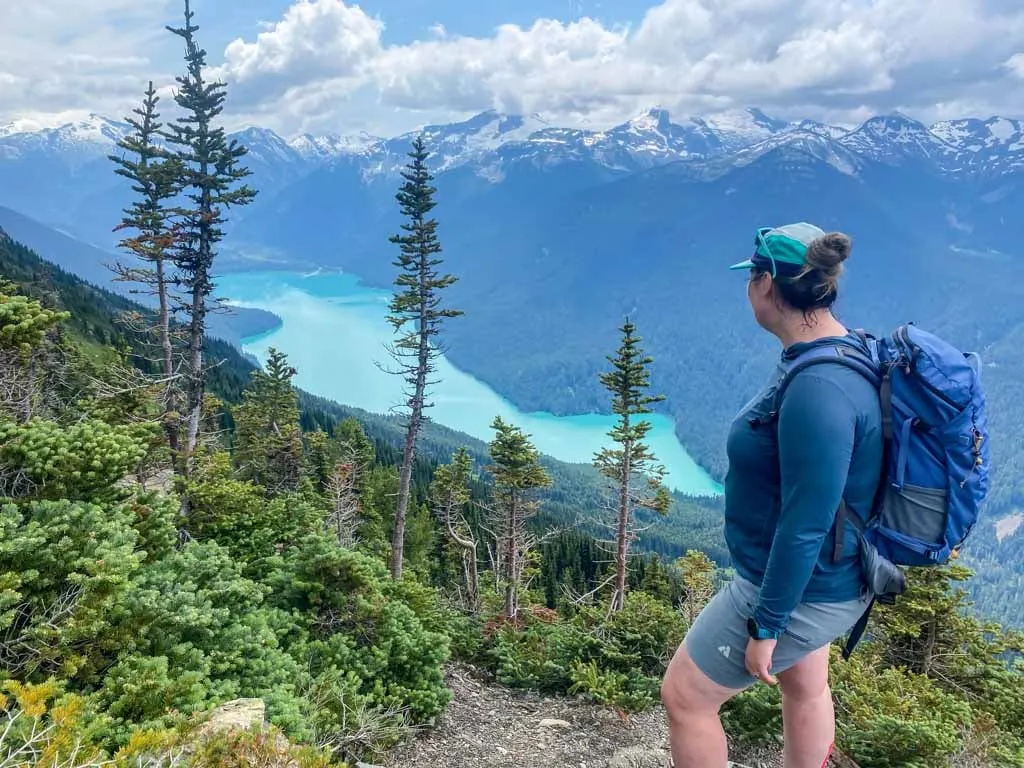
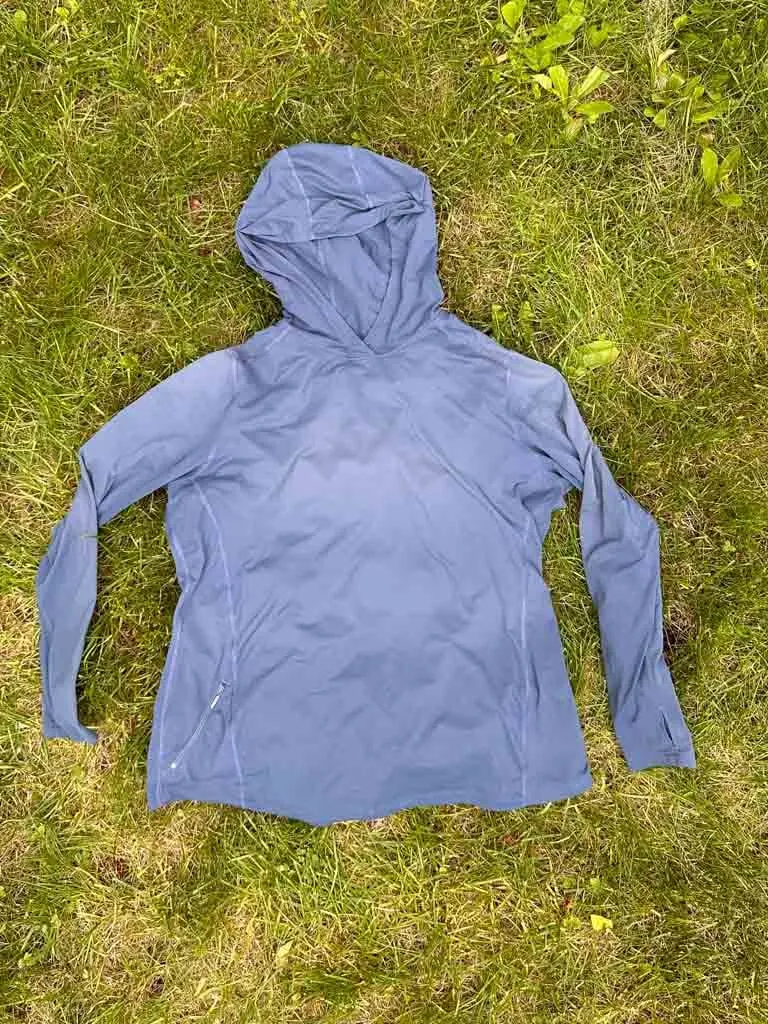
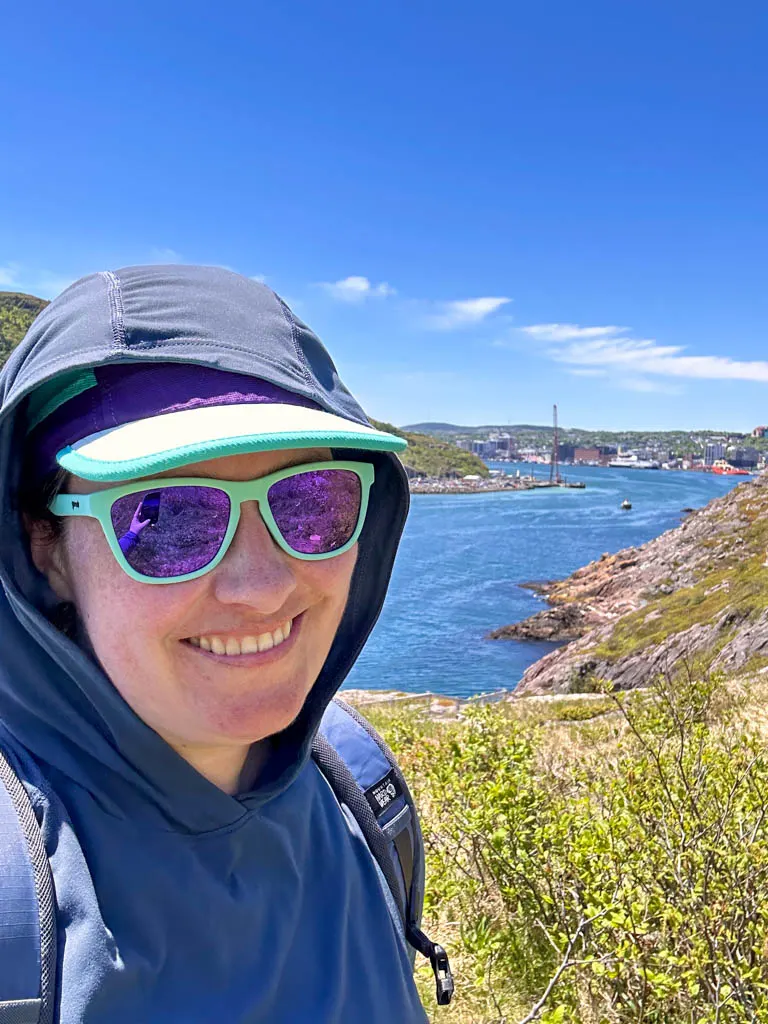
UPF Rating: 50+
Price: $70USD/$80CAD
Fabric: 120 gsm 88% polyester, 12% elastane with HeiQ odor control
Weight: 119g
Pros: Stretchy, lightweight fabric is soft and comfortable when wet or dry, anti-odor treatment works well, has thumb holes
Cons: The drawcord is useless and gets in the way, the hood is very loose-fitting
Where to Buy: REI | Mountain Hardwear USA | Mountain Hardwear Canada | Amazon
The Mountain Hardwear Crater Lake Sun Hoody was the first sun hoodie I got, and it didn’t take long to win me over. I’ve had this shirt for about three years and have worn it on dozens of trips. It made my list of my favourite gear of 2022.
I keep coming back to it thanks to the incredible fabric. It is soft, really stretchy, and relatively lightweight. It also feels good against my skin both wet and dry and doesn’t feel too hot.
The fabric has a HeiQ odor-control treatment that has held up fairly well. I have worn it day after day on multi-day trips and it doesn’t smell too bad at the end.
The cut of the shirt is almost like a basic T-shirt, but it does have panels down the sides, which add a bit of mobility. It also has flatlocked seams, so it doesn’t chafe or rub.
I like the simple thumb holes and slightly longer sleeves are easy to fit over my hands for extra sun protection. But the overlap hood gapes around my neck, which leaves it exposed to the sun. The hood is also a bit oversized compared to others and blows off easily in the wind.
The shirt also has two really useless features: a zippered side pocket and a drawcord at the hem. The side pocket is tiny – it fits a key or a lip balm. But I always have shorts with pockets or a bag of some kind, so I never use it.
The drawcord is ridiculous. I think maybe it’s a style choice since it’s only on the women’s version? It is completely unnecessary, gets caught in your backpack waistbelt, and one time I accidentally peed on it! I cut it out after a few months and haven’t looked back.
Black Diamond Alpenglow Pro Hoody: Best Fully-Featured Sun Hoodie
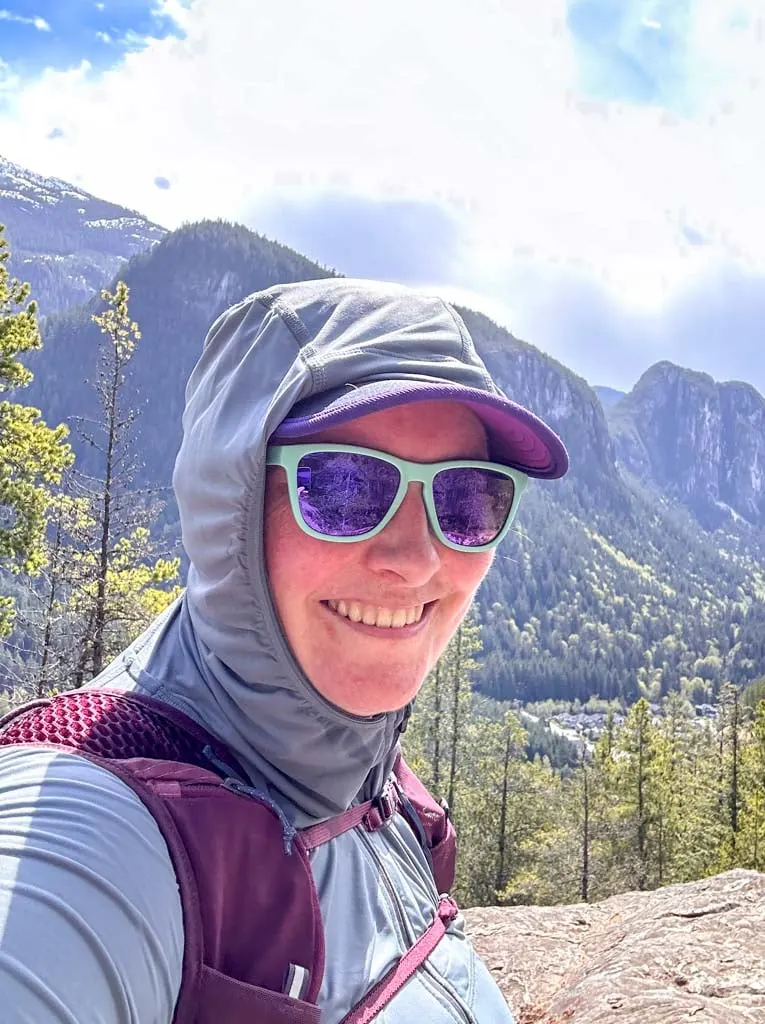
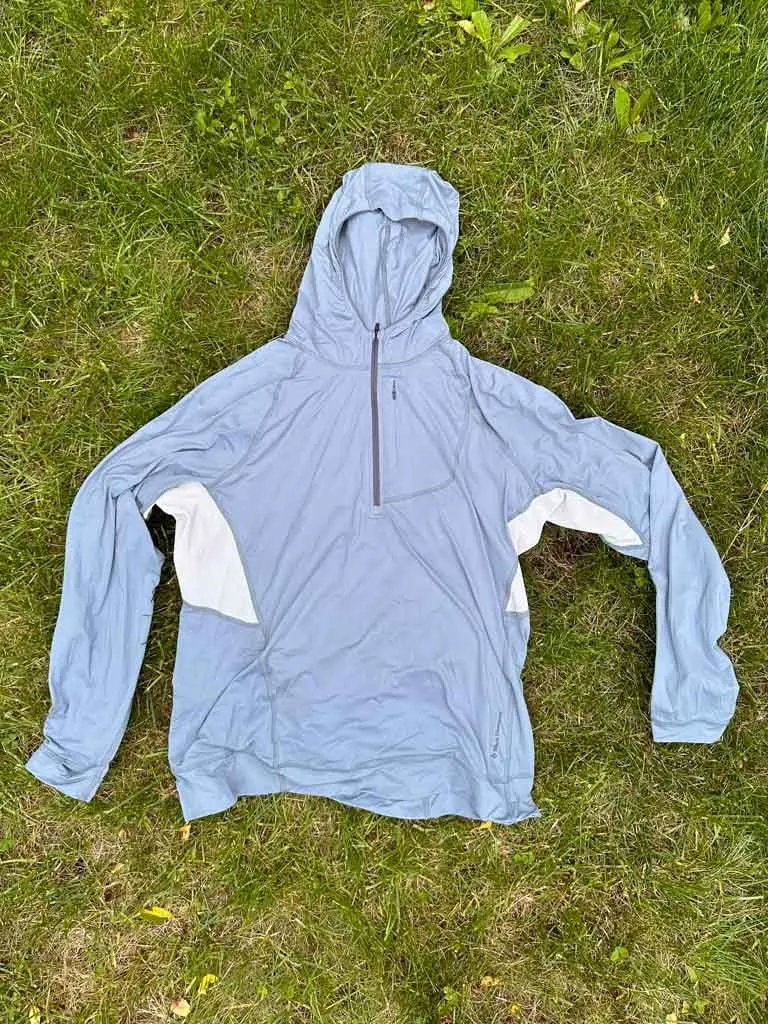

UPF Rating: 50+
Price: $120 USD/$150 CAD
Fabric: 158 gsm 92% nylon, 8% elastane with a DWR finish and Polygiene odor control
Weight: 189g
Pros: Great ventilation, excellent technical fit, especially on the hood and thumb holes
Cons: Expensive, heavy, very “technical” look
Where to buy: Black Diamond | REI | Altitude Sports Canada | Amazon
I got the Black Diamond Alpenglow Pro Hoody just a few months ago, so I haven’t had a chance to really test it on big hikes yet. But so far, I really like how breathable it feels.
The fabric feels cool to the touch, even when dry. And the big mesh panels under the arms are great at dumping heat. I also love the big chest zipper. I can open it up for ventilation in the shade, and unlike the short zippers on some other women’s shirts, it actually goes down to mid-chest.
While I don’t love the way this shirt makes me look like a technical hiking dork, I do appreciate the attention to detail in the way it is made.
The Alpenglow Pro has anatomical patterning with lots of seams that give you range of motion, which isn’t surprising since it’s designed for climbers. The raglan sleeves that won’t chafe under your backpack straps and big underarm gussets so there’s nothing to rub your armpits. It also uses flatlock seams.
It has well-designed thumb holes that lie flat to reduce discomfort if you’re using them with hiking poles. And the hood fits tightly thanks to the elastic edging. This is the only sun hoodie I have that stands up to the wind.
I don’t use the chest pocket, so it seems kind of unnecessary. And all those technical features and construction details make this shirt one of the heaviest and most expensive on the list.
Note: Black Diamond makes another, more basic sun hoody called the Alpenglow (without “Pro” in the name), but I haven’t tried it.
Patagonia Capilene Cool Daily Hoody: Best Casual Sun Hoodie
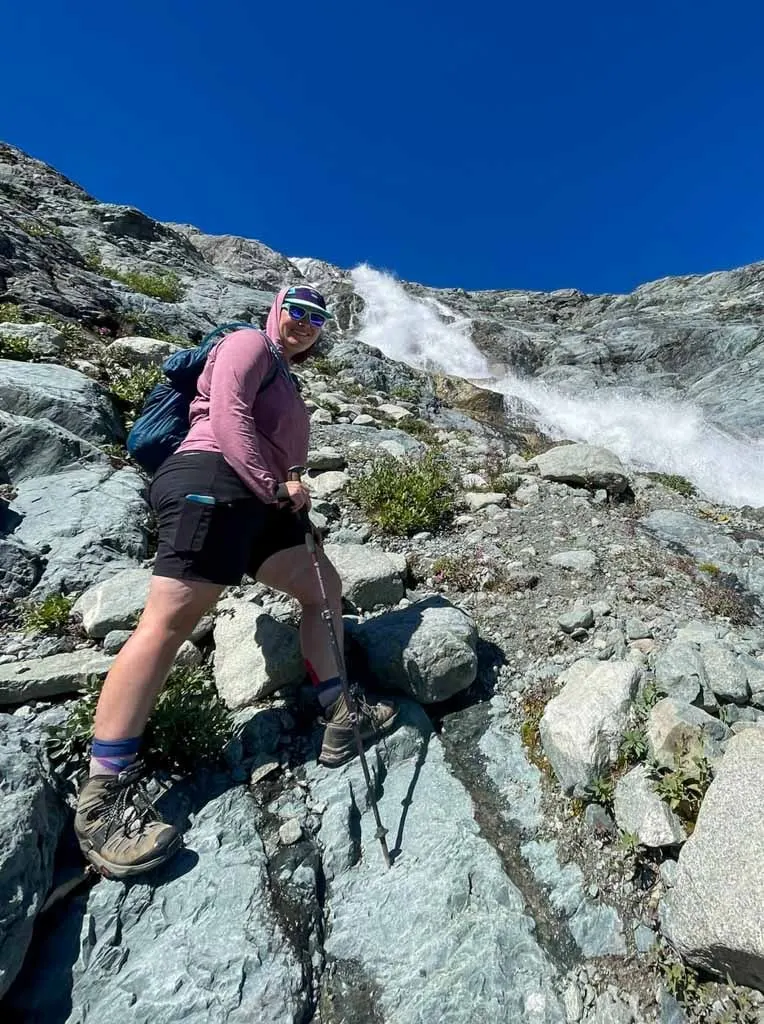
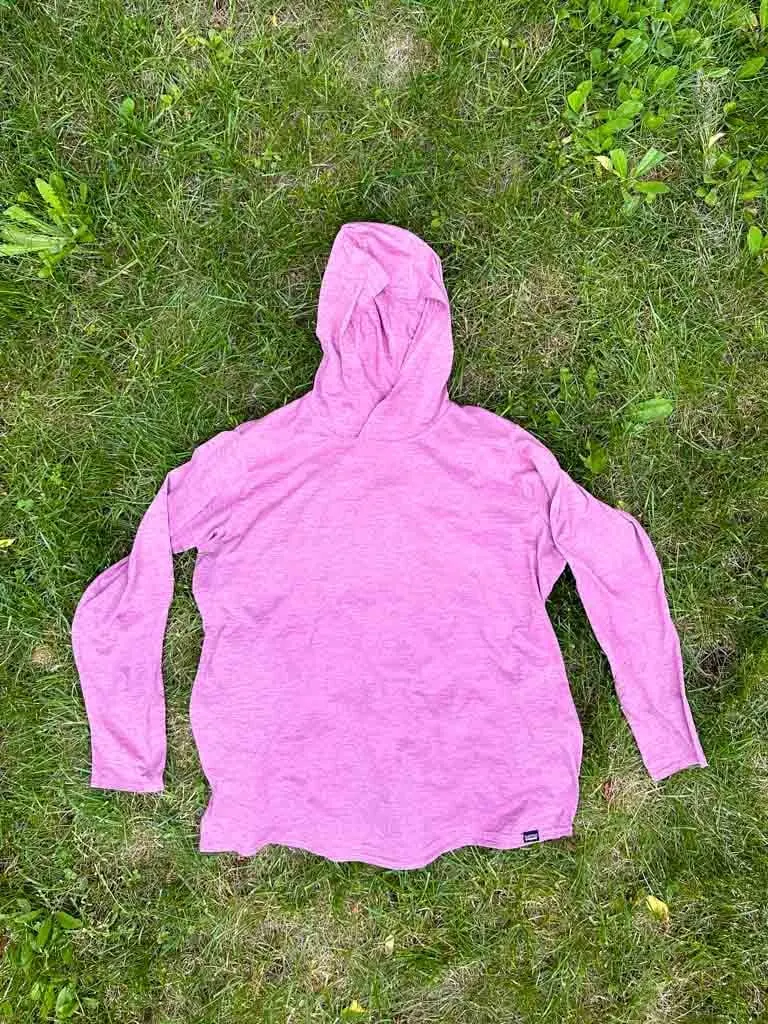
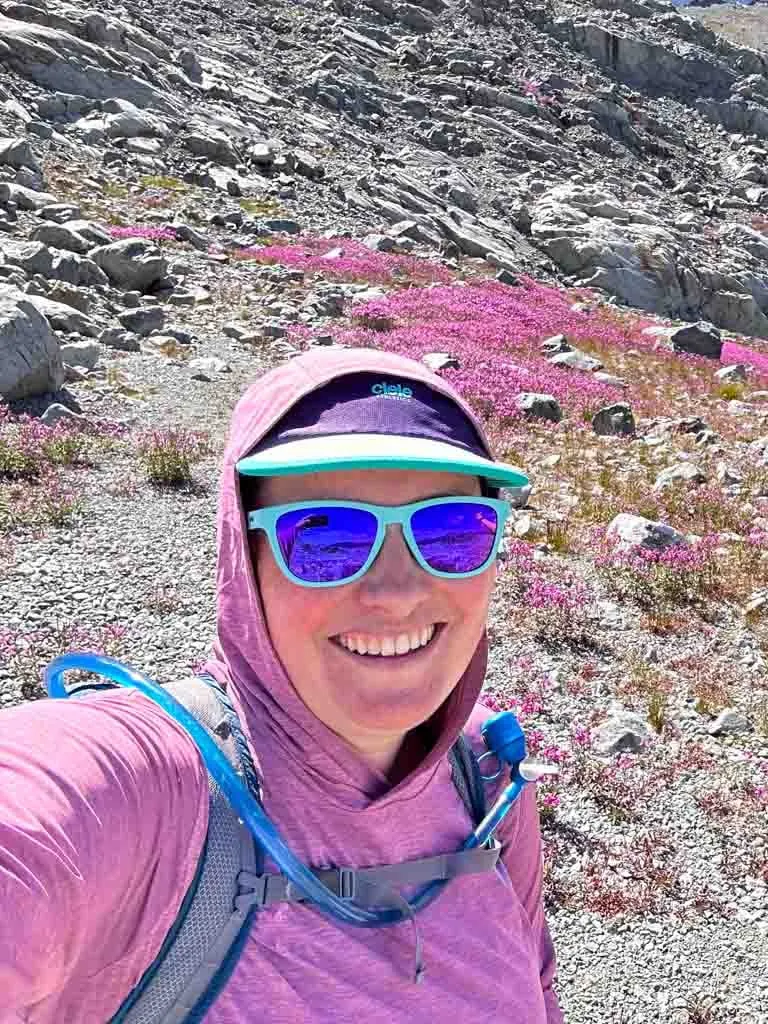
UPF Rating: Not currently rated (previous versions rated 20+)
Price: $65 USD/$79CAD
Fabric: 104 gsm 100% recycled polyester with HeiQ odor control and a wicking finish
Weight: 147g
Pros: Great casual look, fabric feels amazing and doesn’t absorb water
Cons: No UPF rating, only partial flat lock seams, no UPF rating, no thumb holes
Where to buy: Patagonia USA | Patagonia Canada | REI | Altitude Sports Canada
If I just look at the specs, the Patagonia Capilene Cool Daily Hoody doesn’t seem like something I would recommend. For the price, it doesn’t offer that much.
But the reason I keep coming back to this shirt is the fabric. It barely seems to absorb any water and I love the way it feels against my skin when it’s hot out. So far the anti-odor treatment has held up well too. This shirt made my list of my favourite hiking gear of 2023.
While the casual, less technical cut isn’t great for range of motion, I do like that I can wear it to a pub after a hike and blend in a bit more with people in street clothes.
But that less technical cut means that it could be prone to chafing in the armpits and side seams since it uses bulky overlock seams. (The construction section at the bottom of this post has more info.) The hood is also quite loose, so it blows off.
On the negative side, it doesn’t technically have a UPF rating right now because Patagonia had an issue with incorrect UPF numbers on some colors of a previous version of this shirt. Previous versions were rated UPF 20 to 34, which is fairly low for a sun hoody. (See the UPF rating section at the bottom for more info on how the ratings work.)
Outdoor Vitals Tern Ultralight Hoodie: Best Merino Wool Sun Hoodie
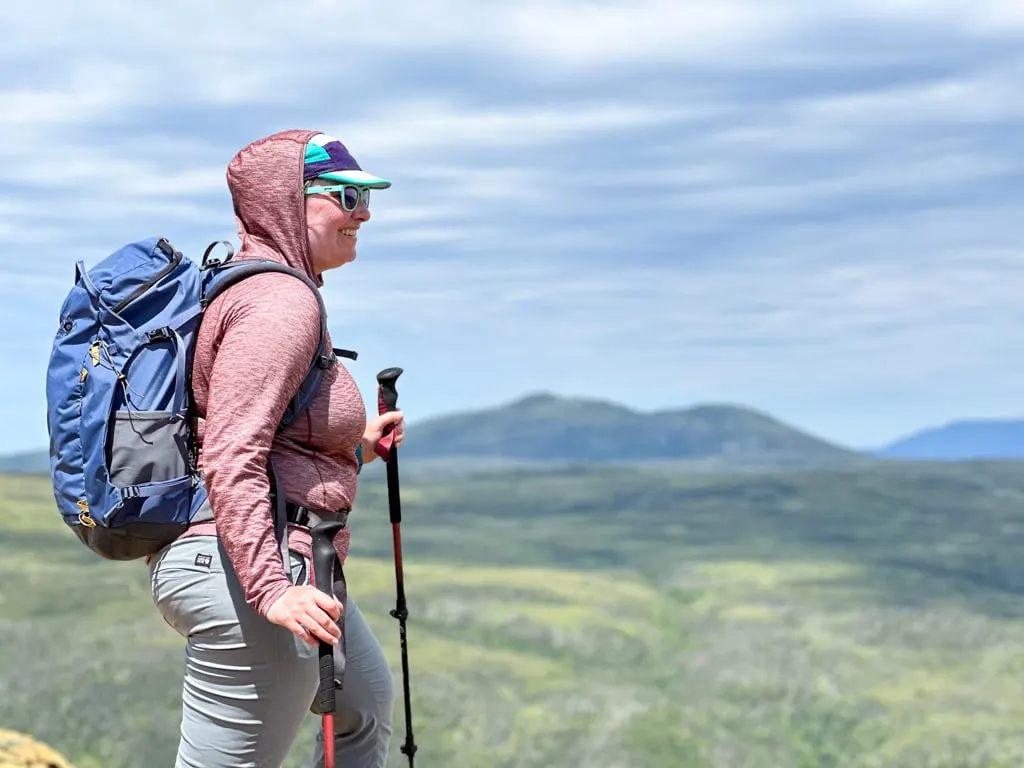
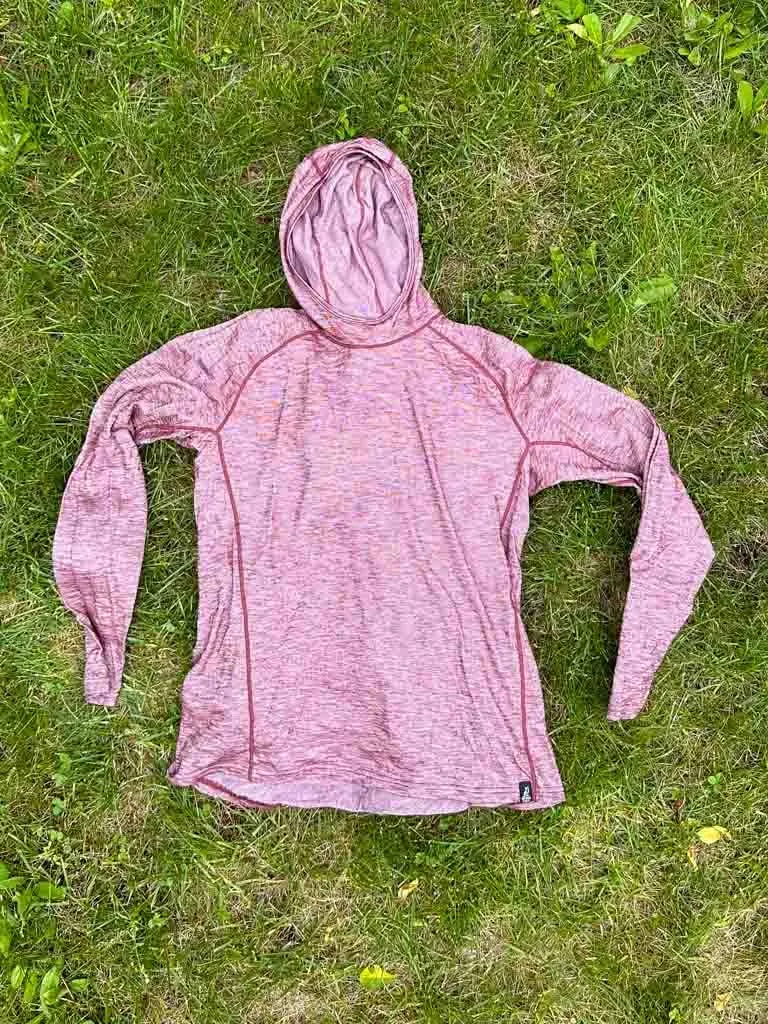
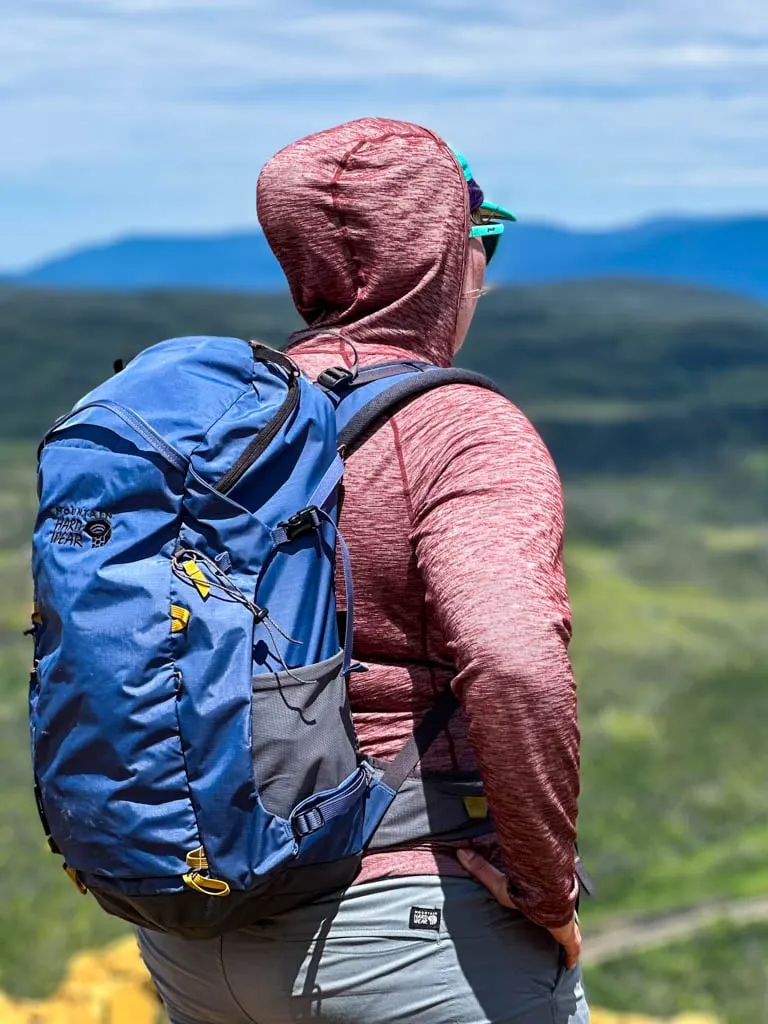
UPF Rating: 36+
Price: $85 USD/$119 CAD
Fabric: 115 gsm 63% Merino wool, 29% polyester, 8% nylon
Weight: 153g
Pros: Built-in anti-microbial properties of Merino will never wear out, stretchy fabric is comfortable
Cons: unisex fit, fabric is prone to pilling, requires delicate wash cycle, no thumb holes
Where to Buy: Outdoor Vitals
If you’ve followed my content for a while, you’ll know that I’m not the biggest fan of Merino wool. So I was pretty skeptical about the Outdoor Vitals Tern Ultralight Hoodie. But like the Odlo Kinship Performance Wool baselayer that made my list of my favourite hiking gear of 2023, it uses a unique NuYarn wool and synthetic blend.
Since the fabric is blended, you get the anti-microbial and temperature-regulating properties of Merino wool as well as the quick-drying property of synthetics. This blend is also super stretchy, which adds lots of comfort. And it’s really thin, which breathes well and cuts down on weight. I do still find it a bit warmer than similar synthetic hoodies though.
The major downside is that the fabric is delicate. I’ve only had this hoodie for a few months, but it already has noticeable pilling, especially on the back lumbar area where it rubs against my backpack. And like all Merino wool, this shirt is a diva when it comes to washing instructions. (But Outdoor Vitals warns about both of these things in their product description, so I knew what I was getting into.)
The construction of this shirt is great with raglan sleeves that are comfortable under backpack straps and underarm gussets for range of motion and less rubbing. It also has flatlock seams throughout. The scuba-style hood also provides more sun protection than the overlap style on most other sun hoodies. I’m surprised it doesn’t have thumb holes though.
But so far the Tern Ultralight Hoodie only comes in a unisex fit, which might not work for all women. I find the fit ok in the size I got, although I think I would have appreciated a bit more room in the chest. Also, the hood doesn’t fit properly if you’ve got long hair tied into a ponytail – it pulls the hood back too far.
Overall, I really like this sun hoodie, especially for colder weather. After using for a season, it made my list of my favourite gear of 2024.
Outdoor Research Echo Hoodie: Best Lightweight Sun Hoodie
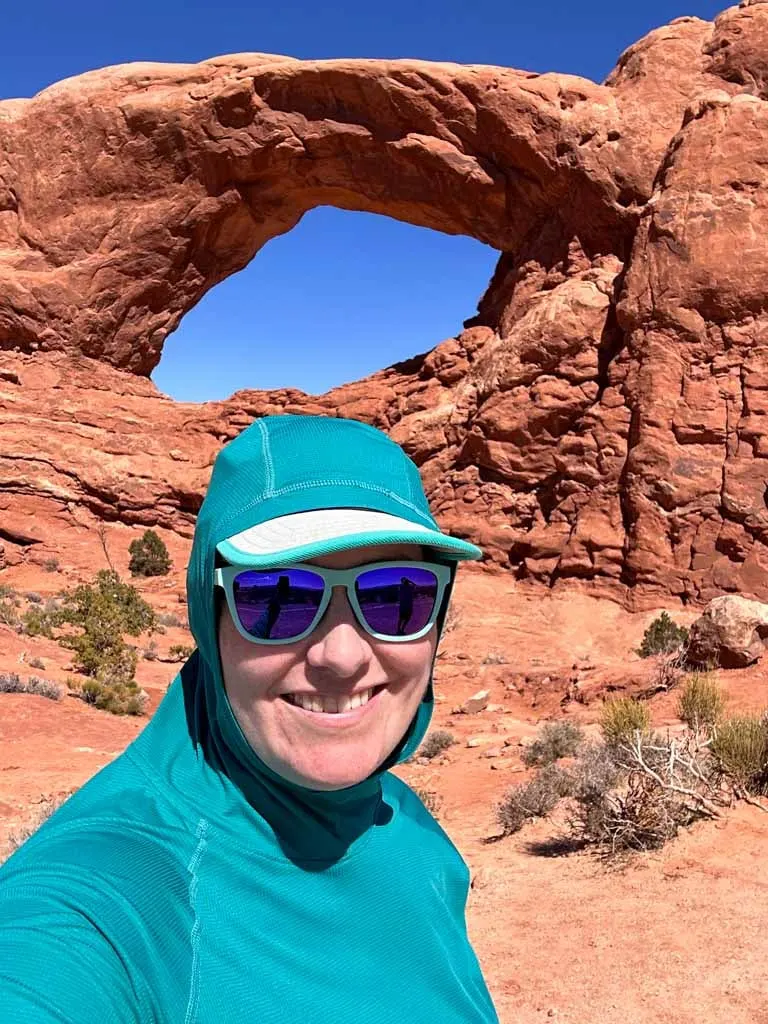
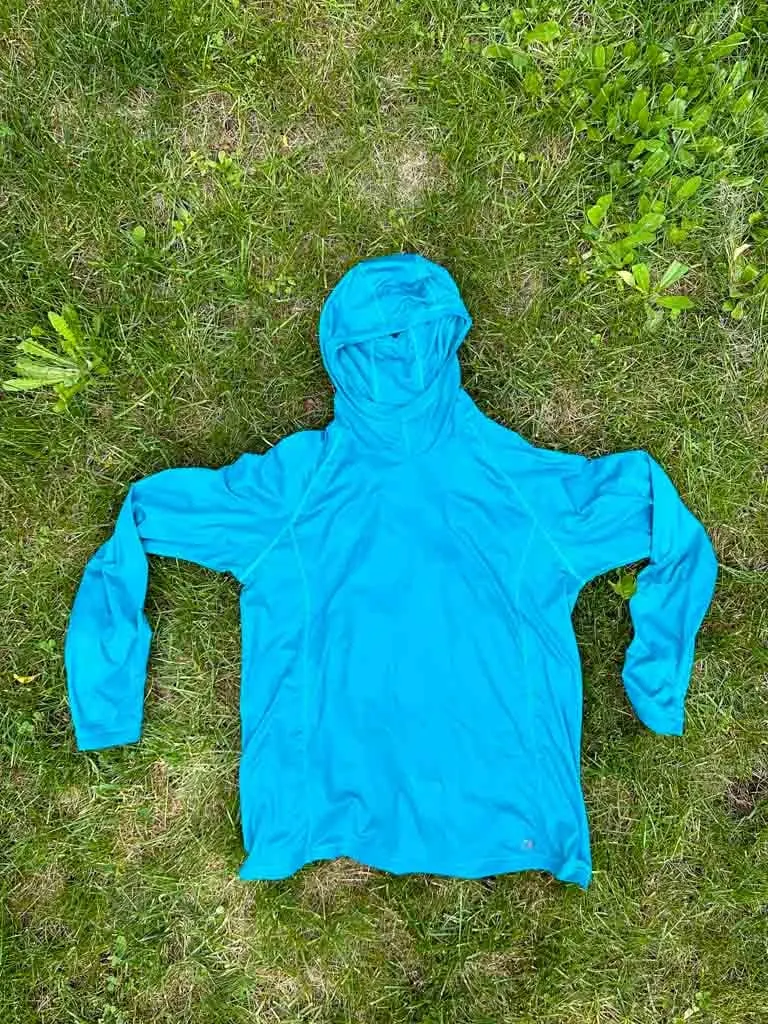

UPF Rating: 15 or 20, depending on color
Price: $75 USD/$90 CAD
Fabric: 100% recycled polyester with odor control
Weight: 112g
Pros: Super light fabric, ponytail port
Cons: Low UPF rating, feels plastic-y when wet
Where to Buy: Outdoor Research | REI | MEC Canada | Amazon
The Outdoor Research Echo Hoody isn’t technically a sun hoodie since it has a low UPF rating of just 15 or 20, depending on the colour. (OR doesn’t market it as a sun hoodie and they actually make a different sun hoodie called the ActiveIce Spectrum Sun Hoodie which I want to try.)
But I’m including it on this list because so many people wear it as a sun hoodie. It’s a popular choice since it is incredibly lightweight and breathable. It also has a great scuba-style hood that fits really closely to keep the sun off your neck.
I really like how light the fabric is on the Echo hoody, but when it gets wet, it feels quite plastic-y and sticks to skin in a way I don’t love. But I have to be sweating a ton for that to happen.
I also love the construction of this hoody – it has all the technical features I’m looking for: flat seams, raglan sleeves, side panels, and thumb holes.
But my favourite part is the ponytail port in the hood – it’s a little overlapping slit at the back to thread your ponytail through. I hate the way my sweaty hair sticks to my neck inside other sun hoodies and this one solves that problem. Unfortunately, only the women’s version has this feature even people of all genders have long hair too.
Helly Hansen Lifa ACTIVE Solen Hoodie: Best Shoulder Season Sun Hoodie

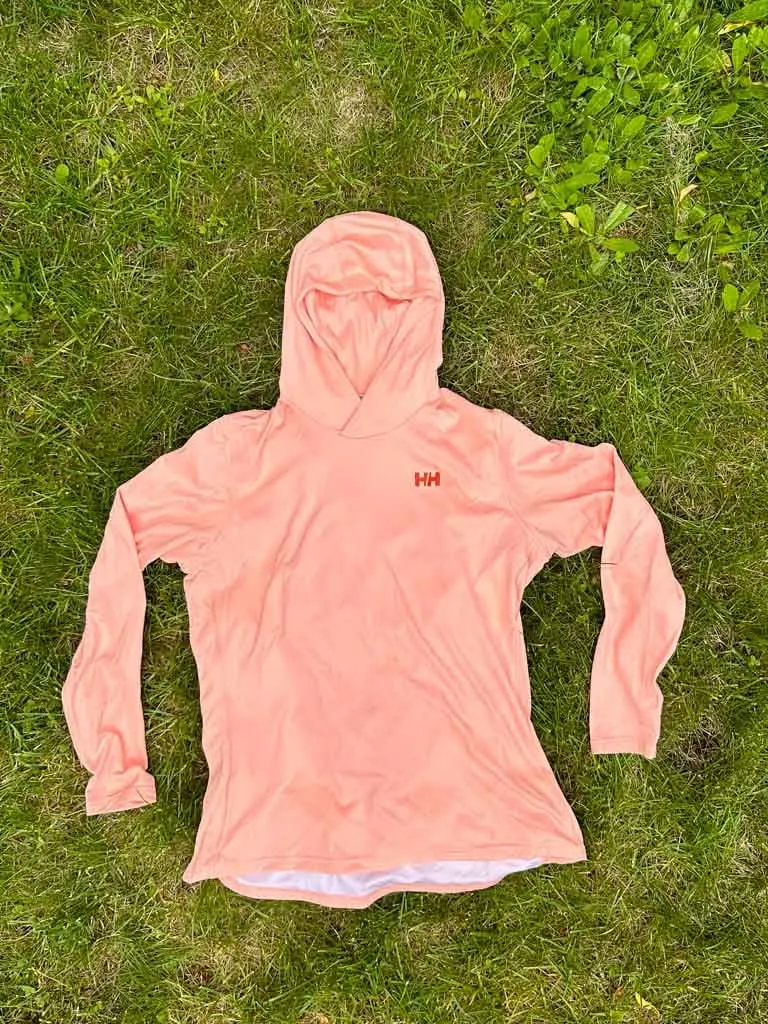

UPF Rating: 50+
Price: $80USD/$90 CAD
Fabric: 60% recycled polyester, 40% polypropylene with S.Cafe odor control
Weight: 210g
Pros: Thicker weight is good for colder temperatures, dries quickly
Cons: Heavy, fabric is prone to snagging and staining, no thumb holes
Where to Buy: Helly Hansen | Amazon | Altitude Sports Canada
The Helly Hansen Lifa Active Solen Hoody is a bit thicker and heavier than other sun hoodies on this list thanks to the double-knit construction. The layer next to your skin is white and then the outside layer is colored. I find it a bit hot in high temperatures, but it is perfect in mid-range temps when it is sunny and you want to hike in just a t-shirt and then put on a jacket when you stop because it’s cold out.
The fabric content on this shirt is a bit different than others on this list because it uses polypropylene blended with polyester. Polypropylene used to be popular in technical wear in the 90s, but most brands have moved away from it since it gets stinky incredibly fast. But, it does wick sweat and dry super fast.
In the Lifa Active Solen, Helly Hansen used an interesting S.Cafe odor control treatment made from coffee to combat the potential stink. In my experience, it works – the shirt doesn’t absorb much water and it dries really fast. And so far it doesn’t smell.
However, my other nitpick with the fabric is that is very prone to snagging. I don’t wear it that often, but it still has tons of small pulls and snags in the fabric. I also wore it on a muddy mountain bike ride and the mud stains have never come all the way out.
The construction of this shirt is pretty basic – it fits like a regular t-shirt for the most part. But it does use flat seams to reduce chafing. And for some reason, the hood has two layers of fabric, which makes it extra heavy and hot.
Other Good Sun Hoodies
Since I’m not made of money and I really don’t need to own any more sun hoodies than I already do, I haven’t tested every single sun hoodie out there. But there are a few more sun hoodies on the market that I’ve heard good things about. (And that I might just be planning to buy.)
REI Co-op Sahara Shade Hoodie: A great budget-friendly option ($50 USD) with a drawstring hood and stretchy fabric.
Outdoor Research ActiveIce Spectrum Sun Hoodie: A similar fit to the OR Echo but with much better sun protection (UPF 50+) and a stretchy fabric with a cooling finish.
Ridge Merino Solstice Hoody: A classic lightweight Merino wool hoody with UPF 30 sun protection at a reasonable price for Merino ($80 USD).
Willit UPF 50+ Sun Protection Hoodie: A cheap Amazon favourite that purports to have UPF 50+ sun protection without being too thick. (Can you tell I’m skeptical?) I recently bought this one and will be testing it soon.
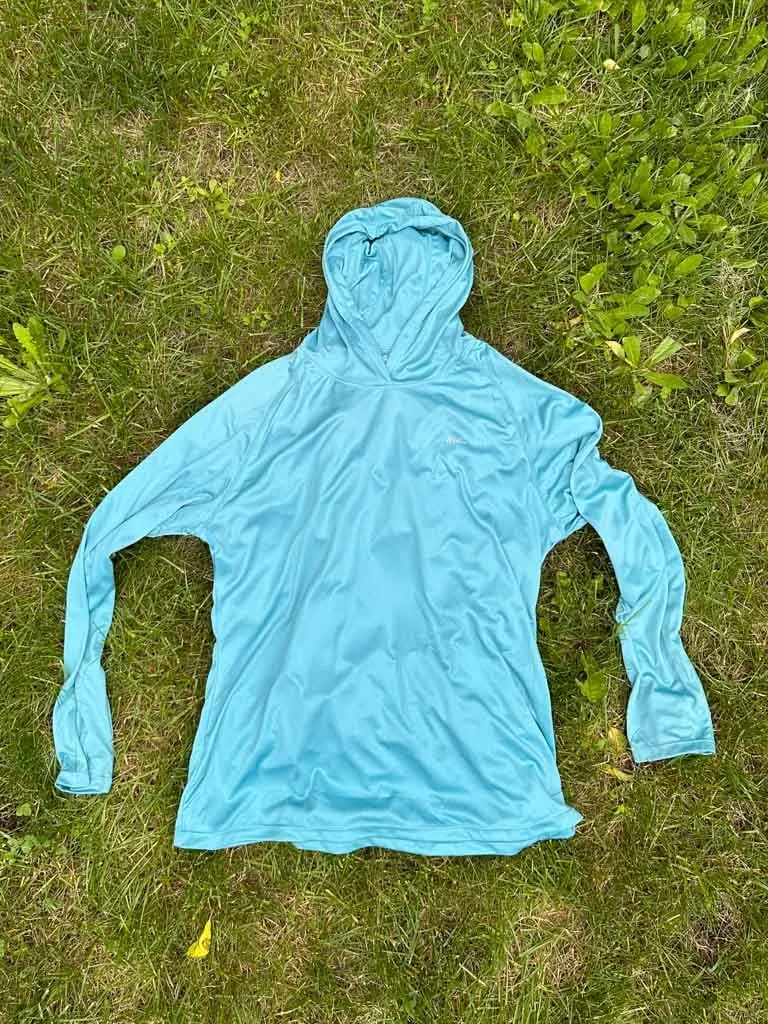
How to Choose a Sun Hoodie
Not all sun hoodies are created equal. There can be huge differences in UPF rating (for sun protection), fabric, construction, and features. In fact, some sun hoodies don’t actually provide that much sun protection at all!
When I worked at the head office of a big outdoor retailer, I spent tons of time talking to the clothing designers and fabric developers to really understand the tech behind outdoor clothing. Below I’m sharing what I’ve learned about choosing a sun hoodie.
UPF Sun Protection
The most important feature of a sun hoodie is that it should actually protect you from the sun.
What Does UPF Mean?
To be marketed as a sun hoodie, a shirt must have a UPF rating. UPF stands for Ultraviolet Protection Factor. It measures how much UVA and UVB radiation can reach your skin through the fabric.
For example, a UPF Rating of 50 means that 1/50th of the sun’s UV rays will reach your skin. Therefore, the fabric blocks 98% of UV rays.
UPF-rated fabrics block both UVB rays (which give you a sunburn) and UVA rays which can lead to skin cancer, wrinkles, sun damage spots, and premature aging.
It’s also worth pointing out that UPF ratings only apply when the fabric is dry. Once the fabric gets wet, the UPF rating goes down.
A quick note: SPF (short for Sun Protection Factor) is the rating system for sunscreen. SPF ratings are a guideline for how much longer you can stay out in the sun without burning. So for example, if you wear SPF 30 sunscreen, you can stay in the sun 30 times longer than with no sunscreen. As well, most sunscreen only protects you from UVB rays, not UVA rays.
What is a “Good” UPF Rating?
The UPF rating scale starts at 15 and maxes out at 50. Wearing a UPF 15-rated shirt sounds good… but it doesn’t provide very good sun protection. In fact, most regular synthetic technical clothing made of polyester or nylon has a UPF rating of about 15.
To really be considered sun-protective, clothing must have a high UPF rating. The American Skin Cancer Foundation will not give a garment their recommendation unless it has a UPF of at least 30. And in the EU, you can’t say clothing provides sun protection unless it has a UPF rating over 40.
That’s why the Patagonia Capilene Cool Daily and Outdoor Research Echo aren’t technically sun hoodies. They do provide more sun protection than not wearing a shirt… but they don’t provide more sun protection than regular shirts.
What Makes Clothing Sun Protective?
It’s fairly easy to make clothing sun protective: make it dark and densely woven. But that won’t make them breathable, lightweight, or comfortable to wear.
For technical hiking clothing to be sun protective, there needs to be a fair amount of science involved, and that’s why sun hoodies can be expensive.
By themselves, polyester, nylon, and Merino wool have more sun protection than cotton. But to make them lightweight and breathable without making them see-through takes some innovation with the way the yarns are knit together to form the fabric.
Usually, the fabric alone won’t have enough UPF protection so they infuse fabric with titanium dioxide – the same stuff that is in sunscreen. Basically, this stuff reflects or absorbs UV rays before they reach your skin.
Low-end shirts (think cheap Chinese sun hoodies on Amazon) use a titanium finish on the shirt that will wash out. That makes your hoodies less protective and has some nasty environmental implications. But higher-end sun hoodies are made with fabric that has titanium dioxide embedded in the yarns of the shirt so they won’t wash out.
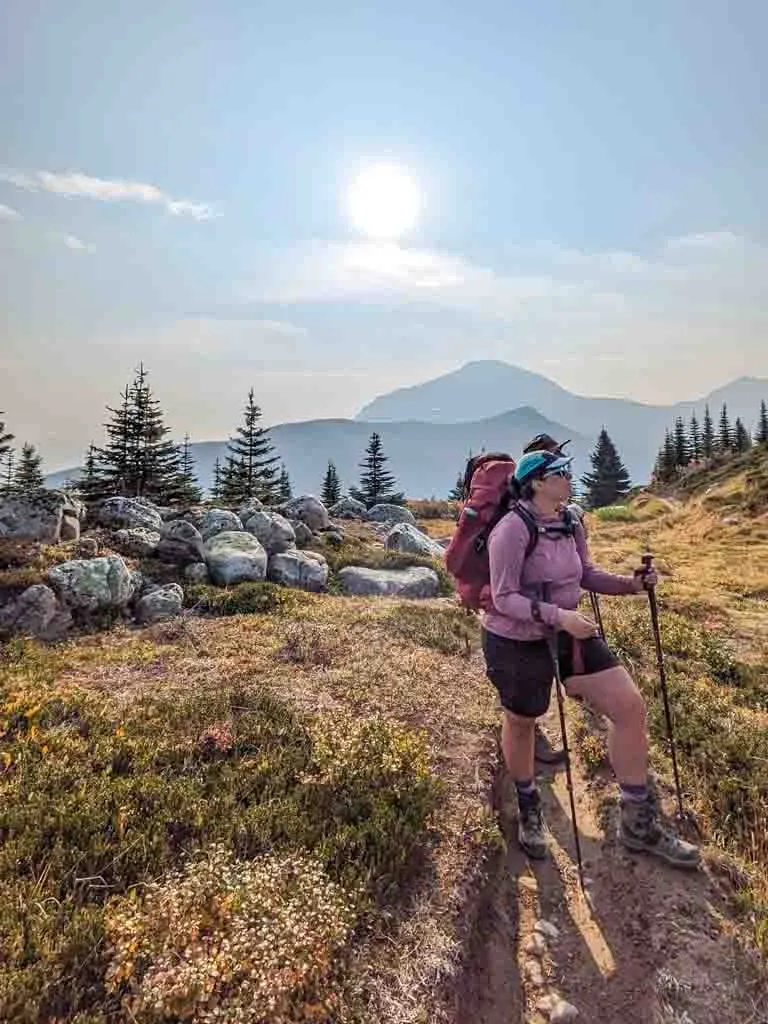
Fabric
Sun hoodies are generally made with technical synthetic or Merino wool fabrics to make sure they are lightweight and breathable. They also usually have a knit structure that mechanically wicks moisture away from your body. Some have a DWR finish or a wicking finish for even better moisture management.
In my opinion, one of the most important things to look for in a sun hoodie is an anti-odor treatment. You are going to be wearing this thing when you’re hot and sweaty. And sometimes, you’ll be wearing it for days at a time before you can wash it. It’s going to stink. Look for odor control or anti-odor treatments like HeiQ.
Note: You can find casual sun hoodies designed for travel or wearing as a bathing suit coverup made with cotton or linen blended with polyester fabric. I don’t recommend these for hiking since they hold on to water, which can chafe and make you uncomfortable. However, in hot and arid desert situations, staying wet can be a good thing.
Construction
The way a shirt is sewn can have a big impact on fit and comfort.
Seams
To start with, a sun hoody is something you wear when you are hot and sweaty, so you want it to be smooth against your skin. The type of seams used matters.
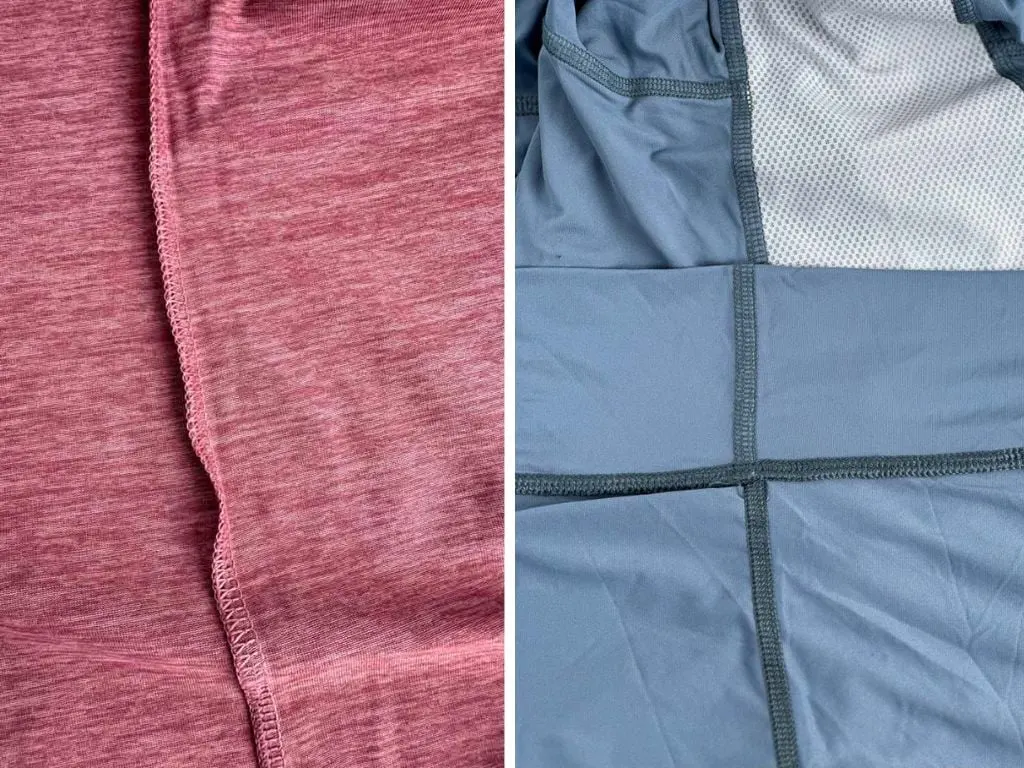
On low-end gear, you’ll find overlock seams. To sew this type of seam, you overlap two pieces of fabric, and then stitch along the edge. The seam sticks out a little, which can irritate your skin. Of the sun hoodies I recommend, only the Patagonia Capilene Cool Daily uses overlock seams.
If you want to avoid chafing, look for flatlock seams. To make a flatlock seam, you place two pieces of fabric side by side, and then stitch them together without any overlap. The result is a seam that lays flat and doesn’t have a bump that can chafe you.
Flatlock seams use more thread so they are stronger and stretchier than overlock seams. However, they are more expensive. The Mountain Hardwear Crater Lake, Black Diamond Alpenglow Pro, Outdoor Vitals Tern Ultralight, Outdoor Research Echo, and Helly Hansen Solen all use flatlock seams.
Construction and Patterning
Patterning describes the way the shirt is sewn together. The placement of the seams is important because it influences fit and comfort.
The standard way to sew a shirt is to put a seam across the top of the shoulders. But if you wear a backpack, this seam can chafe and doesn’t allow for much range of movement. That’s why higher end shirts use raglan sleeves – the type of seams you see on a baseball tee.
The Black Diamond Alpenglow Pro, Outdoor Vitals Tern, and Outdoor Research Echo all have raglan sleeves.
Underarm seams are also important. Standard shirts use just one seam down the side of the shirt (like the Patagonia Capilene Cool Daily). For a better fit, especially while moving, higher-end shirts use side panels. The Mountain Hardwear Crater Lake, Outdoor Research Echo and Helly Hansen Solen all have panels.
For even better fit and range of motion (especially overhead reaching) premium sun hoodies use an underarm gusset. It’s a side panel that extends all the way up through the underarm to the bottom of the sleeve. The Black Diamond Alpenglow Pro and Outdoor Vitals Tern have underarm gussets.
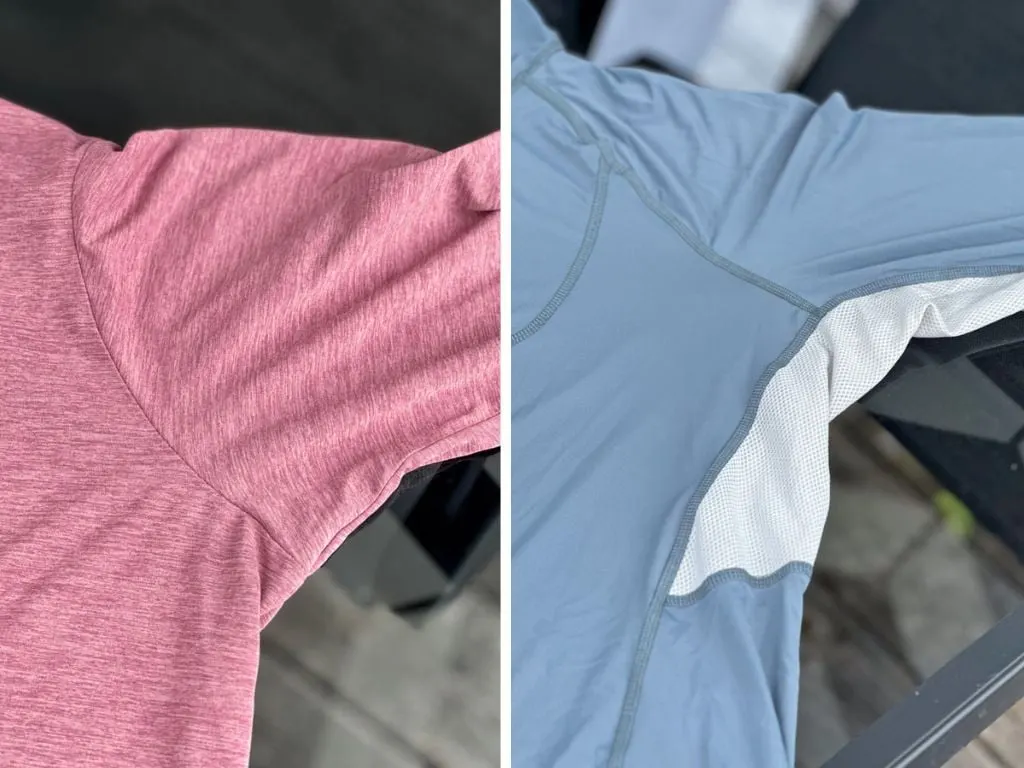
Features
Most sun hoodies are pretty basic. But a few have some extra features that can be handy. Here are some you might want to pay attention to.
Hood Type
Not all hoods are the same. The way the hood is sewn affects fit and sun protection.

Basic hoods have a small overlap of fabric at the bottom. The Mountain Hardwear Crater Lake, Patagonia Capilene Cool, and Helly Hansen Solen have this type of hood.
They tend to fit more loosely, which makes them feel more breathable. They are also cheaper to sew. But depending on how they are sewn (and how big your head is) they provide less sun coverage for your neck.
As well, since they are floppy, they can blow off easily in the wind. I spent a couple weeks hiking in Newfoundland this year and the wind wreaked havoc with my hoods.
The other type of hood is called a scuba hood. Scuba hoods come up high on the neck and have an oval head hole. This provides much better sun protection for your neck and in my experience, stays on better. The Black Diamond Alpenglow Pro, Outdoor Vitals Tern, and Outdoor Research Echo have a scuba hood.
There are a few sun hoodies out there with a drawstring hood adjustment for better fit and sun protection, but I haven’t tried them. My Black Diamond Alpenglow Pro hoody has elastic trim around the edge, which keeps it in place better than some of my other hoods – it’s the only one that doesn’t regularly blow off my head. It’s meant to fit over a climbing helmet (which I haven’t tried) so it’s not super tight.
Thumb Holes
I prefer sun hoodies that have thumb holes. That way you can make sure the sleeves keep the backs of your hands covered. When I was trekking to Annapurna Base Camp in Nepal I learned the hard way that it’s very easy to burn the backs of your hands, especially at high altitudes.

There are lots of different ways to sew thumb holes into a shirt. The cheapest and easiest way is to create a slit along the seam, either along the cuff (for a horizontal hole like the Outdoor Research Echo) or along the side seam (for a vertical hole like the Mountain Hardwear Crater Lake). These methods aren’t that durable, which can make a difference if you use your sun hoodie for biking or climbing. Or if you use trekking poles a lot.
A more sophisticated method of sewing thumb holes is to create a dedicated flap with a separate piece of fabric that forms the cuff. My Black Diamond Alpenglow Pro Hoodie has these and they are way more comfortable to use with trekking poles. They also are more durable since I’m not pressing directly on a seam.
Pockets
I’m usually wearing my sun hoodie with a backpack (which has tons of pockets) and pants, shorts, or hiking leggings (which also have pockets) so I don’t see the need for pockets on a sun hoodie. Nevertheless, some sun hoodies have one.
Sun hoodies typically have small zippered pockets on the chest (like the Black Diamond Alpenglow Pro) or side (like the Mountain Hardwear Crater Lake). They’re big enough to carry a car key, credit card, or lip balm… but not much else.
Mesh Panels
While sun hoodie fabric is generally quite light and breathable, it’s not as breathable as mesh. Some hoodies have mesh panels in the underarms since that’s the area that gets the hottest. But since your underarms aren’t exposed to the sun, you don’t need sun-protective fabric there.
The Black Diamond Alpenglow Pro has mesh underarm panels and I do think they make a bit of a difference in venting excess heat.
Chest Vent
Some hoodies come with a 1/4 length chest zipper. While opening up a zippered chest vent exposes you to the sun, it can be a great way to cool off during shady stretches.
I often open up the chest vent on my Black Diamond Alpenglow Pro, and in general, I love this feature. The only downside is that the top of the zipper can rub your neck or the underside of your chin.
Ponytail Port
Ok, so this isn’t a feature that everyone will want, but I love it! I hate having my sweaty ponytail trapped inside my hood where it makes my neck all gross and damp.
So far, the only sun hoodie I know of with a ponytail port is the Women’s Outdoor Research Echo. Theirs uses an overlapping flap so you don’t notice it’s there until you stick a ponytail through it. I like this feature so much that I’m considering cutting a ponytail hole in some of my other sun hoodies! It also helps keep your hood on your head in the wind.
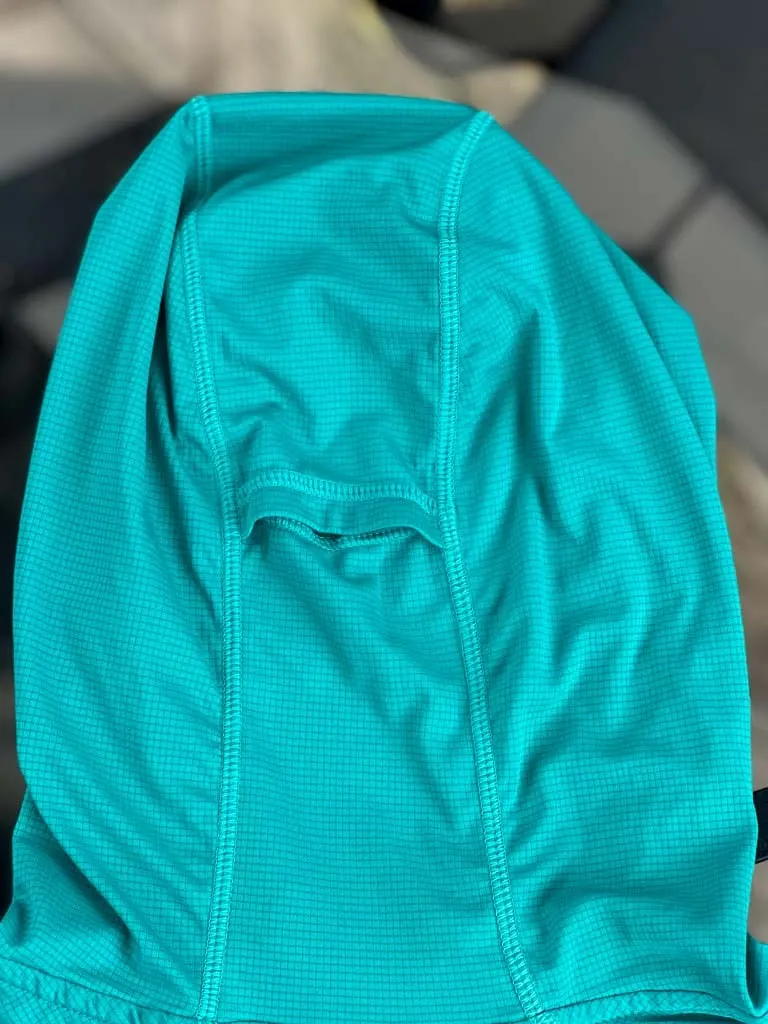
Final Thoughts
Since I got my first sun hoodie a few years ago, I’ve rarely hiked in anything else… and my collection of sun hoodies is now seven strong. I recommend all of the sun hoodies on this list, especially the Mountain Hardwear Crater Lake. But since I haven’t tried all the sun hoodies out there, this is an evolving list – I know I’ll keep searching for the best sun hoodies for hiking.
What’s your favourite sun hoodie? Tell me in the comments?
READ NEXT:
- Tips for Hiking in Hot Weather
- Tips and Tricks for Hiking in the Desert
- Is Merino Wool Worth It? Pros and Cons
- The Best (and Worst) Backpacking Meals Reviewed - December 16, 2025
- My Favourite Hiking Gear of 2025 - December 9, 2025
- Best Insulated Skirts For Hiking and Snowshoeing in 2026 - December 5, 2025

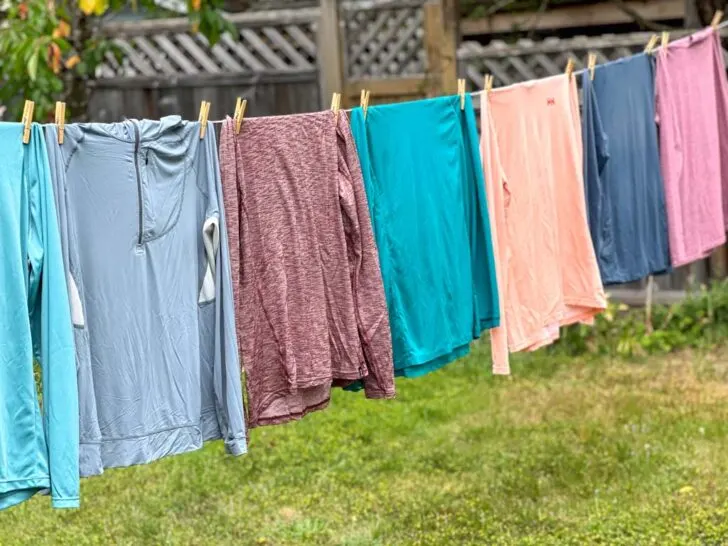
Robert Morris
Wednesday 3rd of July 2024
Hi Taryn, I would highly reccomend Jolly Gear's Triple Crown Button Down as a sunshirt/hoodie. They're a polyester/spandex blend, button up, have a hood with a ponytail port and a cinch, include thumbholes for each sleeve, include two chest pockets that can be used as vents, and they have fun designs.